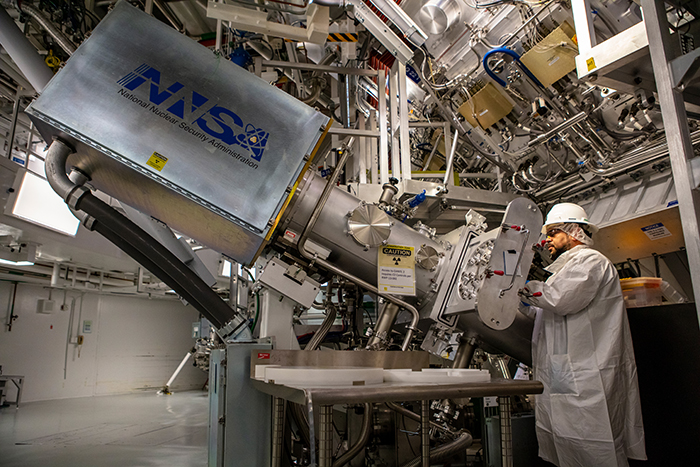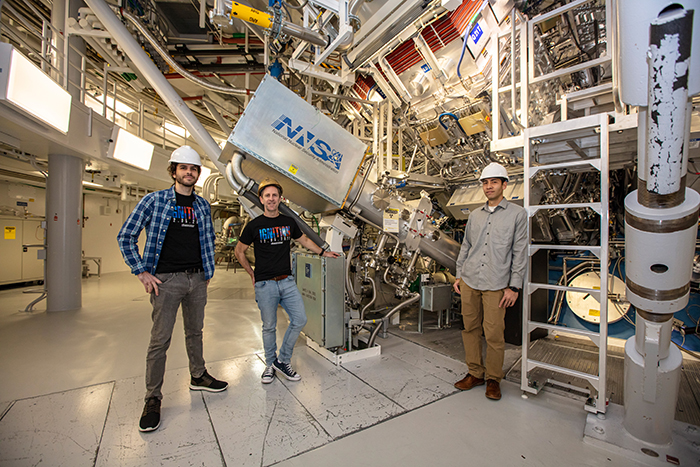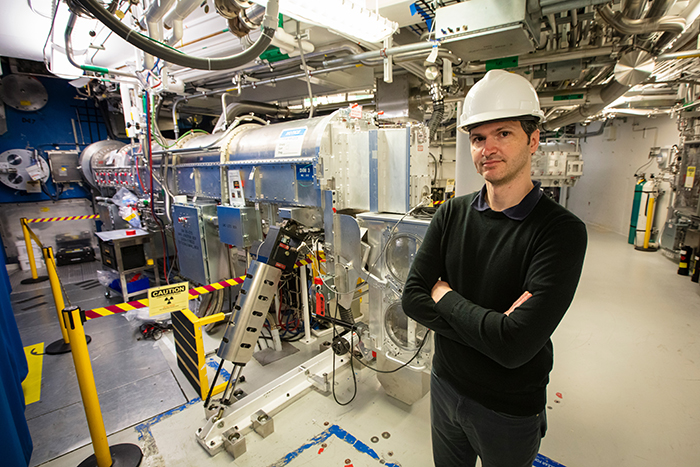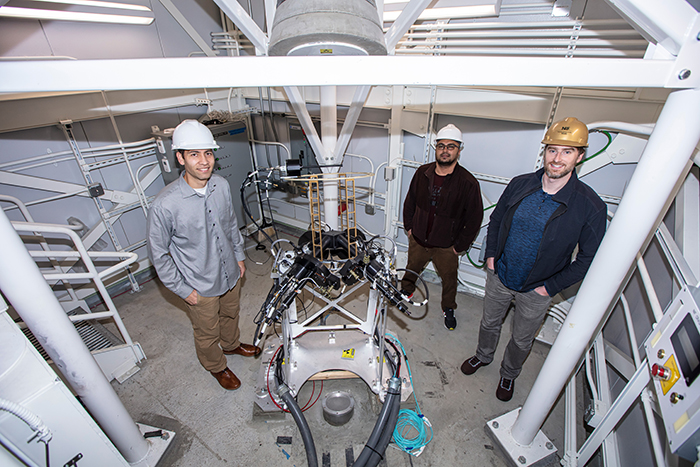Diagnostics Were Crucial to
LLNL’s Historic Ignition Shot
April 12, 2023
Part 7 of “The Age of Ignition,” a NIF & Photon Science News Special Report describing the elements of Lawrence Livermore National Laboratory’s fusion breakthrough at the National Ignition Facility

Diagnostics—specialized, state-of-the-art measuring instruments—played an essential role in LLNL’s Dec. 5, 2022, fusion ignition milestone.
The data collected from NIF diagnostics were “really critical for our progress,” said Arthur Pak, team lead for stagnation science.
“They’ve helped to identify, quantify, and mitigate degradations or loss mechanisms which have impeded our progress,” Pak said. “They allow us to test hypotheses and design changes to understand the conditions of the fusion plasma and the sensitivities of the system.”
 NIF Target Area Operator Henry Deras services the Dante diagnostic, one of the first diagnostics to be installed at the National Ignition Facility. Dante is involved in virtually every NIF shot. Photos by Jason Laurea
NIF Target Area Operator Henry Deras services the Dante diagnostic, one of the first diagnostics to be installed at the National Ignition Facility. Dante is involved in virtually every NIF shot. Photos by Jason Laurea According to Andrew MacKinnon, lead scientist for NIF diagnostics, the approximately 20 instruments used to diagnose the ignition shot were essentially the same as those used on the Aug. 8, 2021, experiment that achieved a then-record 1.35 million joules (MJ) of fusion energy. These optical, x-ray, and nuclear diagnostics continued to play key roles in measuring the performance of experimental campaigns leading up to the fusion ignition shot.
“Success like this drives more developments in the instrumentation.”
—Nino Landen, ICF experiments group leader
NIF’s diagnostics have been developed over decades of ongoing collaborations with national and international partners, including Los Alamos and Sandia national laboratories, the University of Rochester’s Laboratory for Laser Energetics, the Massachusetts Institute of Technology, UC Berkeley, the Nevada National Security Site, National Security Technologies, LLC, the Atomic Weapons Establishment (AWE) in the UK, and the French Alternative Energies and Atomic Energy Commission (CEA) in France. Industrial and commercial partners included General Atomics, Kentech Instruments Ltd., Sydor Technologies, Spectral Instruments Imaging, Keysight Technologies, Tektronix, Photek Ltd., AMETEK, Teledyne Princeton Instruments, Artep LLC, Inrad Optics, and Saint-Gobain.
A Diagnostic ’Workhorse’
The contributions of NIF’s venerable Dante diagnostic were emblematic of the instruments employed in the historic shot.
 Nick Aybar, Michael Rubery, and Eddie Mariscal pose in front of the Dante diagnostic.
Nick Aybar, Michael Rubery, and Eddie Mariscal pose in front of the Dante diagnostic. Dante is actually two diagnostics—Dante 1 and Dante 2—that are involved in nearly every shot. Dante 1 was one of the first diagnostics installed in the late 2000s and is “a workhorse,” according to Michael Rubery, the NIF nuclear physicist in charge of Dante.
These broadband, time-resolved x-ray spectrometers measure the time-dependent soft x-ray power and temperature produced when NIF’s 192 lasers are fired into a hohlraum, the tiny gold cylinder that holds the peppercorn-sized target capsule. NIF, the world’s largest and highest-energy laser, is capable of producing temperatures of more than 3 million degrees Kelvin inside the hohlraum. This creates pressures of hundreds of billions of Earth atmospheres that implode the capsule and fuse the hydrogen fuel (see “How NIF Targets Work”).
Dante measured the energy produced in the target capsule’s “hot spot” during the ignition shot, MacKinnon said. The inertial confinement fusion (ICF) experiment was the first to generate more energy—3.15 megajoules—from the fusion reaction than the laser energy (2.05 MJ) delivered to the hohlraum, thus achieving ignition.
“We had seen indications of this in some of the higher-yield shots since Aug. 8, 2021, but nothing as clear as (the Dec. 5 shot),” MacKinnon said. “It was initially disbelief that gradually morphed into astonishment that we had achieved ignition.”
A New Diagnostic
Since 2021, NIF has added a new diagnostic, the Polar Dilation X-ray Imager (Polar DIXI), that can obtain time-resolved x-ray images at MJ-plus yields, MacKinnon said.
“It’s kind of life changing. I consider myself incredibly lucky to be here at this moment.”
—Michael Rubery
The Target Area Science and Engineering (TASE) team, part of the Lab’s Laser Systems Engineering & Operations (LSEO) program, has developed a comprehensive suite of 140 optical, x-ray, and nuclear diagnostics that help measure the performance of every NIF shot.
The diagnostic suite measures the characteristics of each implosion: the amount of laser energy that gets coupled to the target; the uniformity of the capsule compression; the amount of capsule ablator/fuel mix; the total fusion energy released; and more. This information is fed to computer models to improve researchers’ understanding of the implosion and inform future experimental designs.
The LSEO engineering team is constantly upgrading existing diagnostics while creating new diagnostics in parallel, said Nuclear Diagnostic Engineering Lead Cory Waltz. One example of diagnostic evolution is the Neutron Imaging System (NIS), which was fielded on NIF in collaboration with LANL. The first NIS on NIF was deployed in 2011 and provided a single 2D image of where neutrons are emitted from the hot spot of an implosion.
Since then, Waltz said, the Lab has added two more NIS lines-of-sight (LOS) allowing for the 3D reconstruction of the neutron emitting volume. The design has also evolved to add the ability to image gamma rays on two of the three LOS.
These data, combined with x-ray diagnostic data, can show how items like the capsule fill tube affect the symmetry of the implosion. For the Dec. 5 shot, two of the LOS NIS imagers were fielded and collected data, with initial analysis showing a highly symmetric implosion.
 Clement Trosseille, lead scientist for NIF’s Single-Line-of-Sight (SLOS) and framing camera diagnostics, stands in front of the SLOS.
Clement Trosseille, lead scientist for NIF’s Single-Line-of-Sight (SLOS) and framing camera diagnostics, stands in front of the SLOS. Some diagnostics use snouts to hold equipment that’s inserted into the Target Chamber on diagnostic instrument manipulators (DIMs). These snouts must survive the extreme environment created by a NIF shot. Recently NIF has been increasing the laser energy delivered to targets from a maximum of about 1.9 MJ to the 2.05 MJ used in the ignition shot.
This higher laser energy results in an increased x-ray flux emitted by the target. The surfaces of the diagnostic snouts with a direct line of sight to the target absorb the energy and become superheated, which melts and ablates metal that is ejected before the surface resolidifies; the resulting impulse force recoils down the snout.
One Key Measurement
The Target Diagnostic engineering team uses a LS-DYNA computer model to determine the expected forces along the snout from this recoil, allowing every snout to be engineered to withstand these forces.
 (Left) The Neutron Imaging System 1 (NIS1) snout holds the NIS pinhole assembly about 32 centimeters from the target. (Right) Blast shield on the front of the NIS1 snout. High x-ray flux from the target is absorbed in the stainless-steel shield, heating it up and causing it to melt and eject material before resolidifying. Credit: Cory Waltz
(Left) The Neutron Imaging System 1 (NIS1) snout holds the NIS pinhole assembly about 32 centimeters from the target. (Right) Blast shield on the front of the NIS1 snout. High x-ray flux from the target is absorbed in the stainless-steel shield, heating it up and causing it to melt and eject material before resolidifying. Credit: Cory Waltz One key diagnostic measurement from the ignition shot was the total fusion energy yield, indirectly determined by measuring the number of neutrons emitted from the capsule.
Each deuterium-tritium (DT) fusion reaction emits one neutron, one alpha particle, and 17.6 million electron-volts (MeV) of kinetic energy shared between the two particles. Determining the number of neutrons emitted gives the number of fusion reactions that occurred, and multiplying this number by the energy per fusion provides the total fusion yield.
According to Waltz, the official yield measurement on Dec. 5 came from two absolute yield diagnostics: the Magnetic Recoil Spectrometer (MRS), which was developed in collaboration with MIT, and the Zirconium Neutron Activation Detector (NAD).
The Zirconium 90 isotope within the NAD sample becomes activated when it reacts with neutrons above energies of 12.1 MeV, allowing it to be a good measure of the 14 MeV neutron flux emitted from the target while not measuring lower-energy background neutrons. The activated Zirconium decays, emitting gamma radiation with a known half-life that is measured after the experiment to determine the total initial activation from the shot. This can then be correlated to the neutron yield the shot had to produce to create the initial activation.
A Future of Possibilities
LLNL’s ignition shot was just a few hours old when ICF Experiments Group Leader Nino Landen was already focused beyond the historic event and excited about the possibilities that had suddenly opened up.
“I tend to look to the future,” he said, “and I was thinking, ‘Wow, what does it mean for going further?’ Because this shot exceeded my expectations relative to Aug. 8, 2021; this provided an opportunity to refine our extrapolations.”
 Eddie Mariscal, Justin Jeet, and Shaun Kerr are inside the North Pole neutron time-of-flight (nTOF) enclosure that detects and records neutrons released during NIF’s laser-driven implosions.
Eddie Mariscal, Justin Jeet, and Shaun Kerr are inside the North Pole neutron time-of-flight (nTOF) enclosure that detects and records neutrons released during NIF’s laser-driven implosions. Landen recalculated extrapolations that day based on anticipating more NIF laser energy and a more efficient hohlraum in the future. “That, to me, is the most exciting part that visually shows that with both the existing NIF and a slightly upgraded NIF, the potential has gone up in terms of what it can do,” he said.
“The good news is that success like this drives more developments in the instrumentation. We really want to look for ‘gotchas’ and are trying to stay a little bit ahead of the game by adding instrumentation to look at why things maybe don’t perform as we expect.”
Landen likened the ignition achievement to climbing a ladder. “We didn’t know if there was another rung on the ladder—and now we know there is,” he said. “We’re moving up the ladder faster and faster in terms of the yield. It’s progressing more quickly, which is just what you’d expect once you get ignition. Things can get easier post ignition.”
Rubery echoed Landen’s excitement over the ignition breakthrough.
“It’s kind of life changing,” Rubery said. “I consider myself incredibly lucky to be here at this moment.”
Next Up: “Target Evolution is a Key to NIF’s Continued Success”
More Information:
Keys to Our Success: Diagnostics
“NIF Diagnostics Played Key Role in Fusion Milestone,” NIF & Photon Science News, November 8, 2021
“NIF Implosions Shown to Have Significant 3D Asymmetries,” NIF & Photon Science News, August 27, 2020
“Nuclear Diagnostics Help Pave the Way to Ignition on NIF,” NIF & Photon Science News, March 6, 2020
“Discovery Science Inspires Novel Diagnostics for NIF,” NIF & Photon Science News, December, 2018
—Jon Kawamoto
Follow us on Twitter: @lasers_llnl



